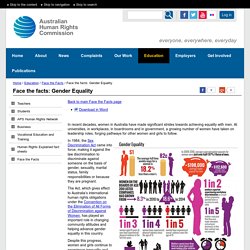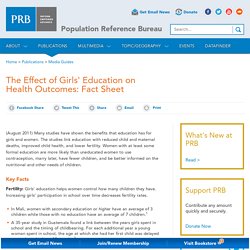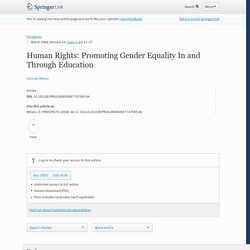

Gender Pay Gap Factsheet. Face the facts: Gender Equality. Back to main Face the Facts page Download in Word In recent decades, women in Australia have made significant strides towards achieving equality with men.

At universities, in workplaces, in boardrooms and in government, a growing number of women have taken on leadership roles, forging pathways for other women and girls to follow. In 1984, the Sex Discrimination Act came into force, making it against the law discrimination to discriminate against someone on the basis of gender, sexuality, marital status, family responsibilities or because they are pregnant. The Act, which gives effect to Australia’s international human rights obligations under the Convention on the Elimination of All Forms of Discrimination against Women, has played an important role in changing community attitudes and helping advance gender equality in this country.
The Simple Truth about the Gender Pay Gap (Spring 2016): AAUW. You’ve probably heard that men are paid more than women are paid over their lifetimes.

But what does that mean? Are women paid less because they choose lower-paying jobs? Is it because more women work part time than men do? Or is it because women have more caregiving responsibilities? And what, exactly, does gender bias have to do with paychecks? AAUW’s The Simple Truth about the Gender Pay Gap succinctly addresses these issues by going beyond the widely reported 80 percent statistic. Quick Facts According to AAUW, the pay gap won’t close until 2152. Think 80 cents is bad? The gender pay gap is worse for mothers, and it only grows with age. Australian men paid an average of 20 per cent more than women. Updated Men in Australia are still paid on average about 20 per cent more than women, according to a workforce diversity specialist, with figures from the Australian Council of Trade Unions showing the gender pay gap has grown steadily over the last decade.

In addition, men and women are paid differently despite performing the same role within Australia's top accounting firms, workforce diversity specialist Conrad Liveris told PM. Mr Liveris claims top accounting firms including PriceWaterHouse Coopers, EY and Deloitte are paying men and women differently for the same roles with pay gaps ranging from 1 to 5 per cent. "Even at their highest level, at the partnership level, they were finding about a 5 per cent gender pay gap in a like-for-like basis," Mr Liveris said. Deloitte declined a request for an interview but in a written statement the accounting firm said: Global Development podcast: gender equality. Gender inequality remains one of the top development challenges of the 21st century.

Women and girls continue to fare worse across many headline development indicators - from poverty and health to education and political participation. But what's holding back progress on gender equality? And what can be done to make the world a better place for women and girls? In this edition of our new Global Development podcast, we look at the impact of the global financial crisis on women around the world, examine new ideas to push forward progress on gender issues, and ask what can be done to tackle gender-based inequalities in the 21st century.
To discuss these issues, Madeleine Bunting is joined in the studio by Rachel Moussié, women's rights adviser on economic policy at ActionAid International, and Jane Martinson, women's editor at the Guardian. Chief of Army message regarding unacceptable behaviour. The Effect of Girls' Education on Health Outcomes: Fact Sheet. (August 2011) Many studies have shown the benefits that education has for girls and women.

The studies link education with reduced child and maternal deaths, improved child health, and lower fertility. Women with at least some formal education are more likely than uneducated women to use contraception, marry later, have fewer children, and be better informed on the nutritional and other needs of children. Fertility: Girls' education helps women control how many children they have. Increasing girls' participation in school over time decreases fertility rates. In Mali, women with secondary education or higher have an average of 3 children while those with no education have an average of 7 children.1 A 35-year study in Guatemala found a link between the years girls spent in school and the timing of childbearing. Maternal Health: Increasing girls' access to education improves maternal health.
Child Survival: Increasing girls' education has positive effects on infant and child health. The Girl Effect. A normal girl's abnormal Life due to her Basic Knowledge lack - Change Girls life. United Nations: Gender equality and women's empowerment. Human Rights: Promoting Gender Equality In and Through Education. Bredie, J.W.B.; Beeharry, G.K. 1998.

School enrolment decline in Sub-Saharan Africa: beyond the supply constraint. Washington, DC: World Bank. (World Bank discussion paper, 395.)Gaynor, C. 1997. The supply, condition and professional development of women teachers. Paris: International Institute for Educational Planning.Melchiorre, A. 2002. What stands in the way of women being equal to men? Gender equality: A view from the loo, Isha Ray:TED.